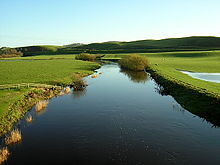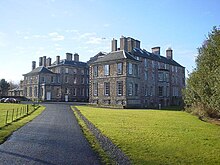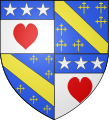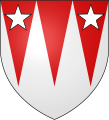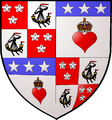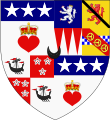Clan Douglas
The Douglas ( Gaelic : dubh glass for "dark stream" ) are a Scottish noble family known since the 12th century .
During the 14th and 15th centuries, the "Black Douglas" line played a prominent role in Scottish history, rivaling the royal family for power, while the "Red Douglas" took over this role in the 16th and 17th centuries.
history
The Douglas are an old Scottish clan from the Central Lowlands , who named themselves after the place Douglas in South Lanarkshire , where the ruins of the ancestral seat Douglas Castle are . The place, in turn, takes its name from the Douglas Water stream ( Gaelic : dubh glass , Old Gaelic: dub glais , dark stream). From there the clan spread and acquired extensive lands in the Scottish Borders , Angus , Lothian , Moray and France. In the late Middle Ages , the Douglas were the most important family of the Lowlands, often members of the clan exercised the actual power behind the throne of the Stuart kings.
Origins
The descent from a mythical Sholto Douglas , who is said to have won a battle against a rival to the throne for an equally mythical Scottish king Solvathius around the year 767, is not documented. The progenitor was probably Theobaldus Flammatius (Theobald the Flemming, i.e. the Flame ), who received property on Douglas Water in Lanarkshire from the Abbot of Kelso as a fief in 1147 . In the 12th century, some Flemish and Norman nobles had accepted the Scottish King's invitation to settle in Scotland. For the first time a William of Douglas (possibly a son of the mentioned Theobald) appears as a witness at the end of the 12th century in a deed of donation from Bishop Joscelin of Glasgow in favor of the monks of Kelso. The leading names of the following generations, Arkenbald and Freskin , indicate a relationship to the Murray clan , which also has a similar coat of arms (with three stars). William's son was Archibald of Douglas (before 1198–1238), his son was William Longleg (Langbein) of Douglas (around 1220 – around 1274), his son William the Hardy (the Bold) of Douglas (after 1243 – around 1298) .
Hardy's son, in turn, was the Black Douglas , James Douglas, Laird of Douglas , to whom the heart in the family's coat of arms goes back. There is an embalmed heart under the original three stars, as James had promised to bring the heart of the Scottish King Robert the Bruce to the Holy Land as atonement for a murder, but he only got as far as Spain and fell there fighting the Moors. His descendants were allowed to include the heart in their coat of arms. The episode is immortalized in the ballad Das Herz von Douglas by Moritz Graf von Strachwitz (see below, web links).
Another son of Archibald I was Andrew Douglas of Hermiston († 1277), progenitor of the Lairds of Dalkeith and Earls of Morton and the Douglas of Mains .
The Lairds of Douglas later split into two lines, a "black" under the leadership of the Earls of Douglas and a "red" led by the Earls of Angus .
The black line
James Douglas , the "Black", successfully took part in many battles for King Robert the Bruce , according to legend, there should have been 70. After the battle of Bannockburn in 1314 he received numerous lands from the king and thus laid the foundation for the long existence of his family.
After his death on the crusade in Spain, his nephew William Douglas inherited the family property and in 1358 received the title of Earl of Douglas from the new King David II. William's son James Douglas, 2nd Earl of Douglas , fell in 1388 in the battle against the English. Since he left no heir, his earl dignity fell to his cousin Archibald Douglas, 3rd Earl of Douglas , a bastard son of the "Black Douglas". Archibald's power later surpassed that of the paralyzed King Robert III. , he brought about the peace treaty with England in 1390. His son, Archibald Douglas, 4th Earl of Douglas , who was one of three daughters of Robert III. had married (the other two were also married to Douglas men) fought in France in the Hundred Years War against the English and was made Duke of Touraine there in 1424 . He fell in 1424 at the Battle of Verneuil . His son Archibald Douglas, 5th Earl of Douglas was from 1437 until his death in 1439 Regent of Scotland for the underage James II. His two sons, William Douglas, 6th Earl of Douglas and David, were - as young people - victims of a court intrigue by beheading her in 1440 at the so-called "Black Dinner" at Edinburgh Castle .
They were followed by their great uncle James the Gross, Earl of Avondale as 7th Earl of Douglas. He was married to Beatrice Stuart, a cousin of King James I , who died in 1437 . His son James II tried, however, to break the supremacy of the Douglas family and to appropriate their lands, which plunged Scotland into a civil war. In 1452 James Douglas' son William Douglas, 8th Earl of Douglas near Stirling, was stabbed to death by King James II himself. Since William had opposed the king's plans for social reform, the latter accused the Douglas family of treason and took this as an opportunity to confiscate all their goods and possessions. William's brother James Douglas, 9th Earl of Douglas , then carried out an armed uprising, but was defeated at the Battle of Arkinholm in 1455 and fled - stripped of all his possessions - to England , from where he took part in an attempted invasion of Scotland in 1484. but in which he was captured; he died in custody in 1491. With James, the Earls of Douglas and the black line of the family went extinct. Large parts of his property had been transferred by the Scottish king to the members of the red line of the Douglas family.
The red line
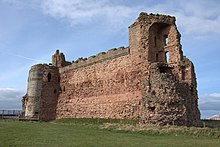
The founder of the "Red Douglas" was George Douglas, 1st Earl of Angus , an illegitimate son of William, 1st Earl of Douglas. He married Mary, daughter of King Robert III , in 1397 . and then received the title of Earl of Angus . The following generations are of lesser interest and were overshadowed by the mighty "Black Douglas". For this only occurred Archibald Douglas, 6th Earl of Angus , indicate the 1509 Margaret Tudor married the widow of King James IV. Of Scotland and sister of King Henry VIII. Of England . Soon there was turmoil between the spouses and fights for guardianship for the underage Jacob V , during which the 6th Earl of Angus temporarily gained the reign and imprisoned the young king in order to secure his own power. He entrusted his uncle Archibald Douglas of Kilspindie (1475-1536) with the education. Theodor Fontane's ballad Archibald Douglas refers to the latter Archibald (see below, web links).
From the marriage of the 6th Earl of Angus and Margaret Tudors, Lady Margaret Douglas emerged, who married the Scottish nobleman Matthew Stuart, Earl of Lennox and thus a scion from the Scottish royal house of the Stuarts . Their son Henry Stewart, Lord Darnley , later married Queen Maria Stuart , his first cousin, and thus united the Stuarts' claims to the English throne. Another Douglas was involved in her tragic fate, James Douglas, 4th Earl of Morton , a nephew of the 6th Earl of Angus. In 1566 he murdered Mary's favorite Rizzio , together with his great cousin Darnley and some other nobles, and in the following year Darnley himself, together with Bothwell ; after his marriage to Maria, he forced the latter to abdicate, whereupon she fled to England, where she was later beheaded. For the underage son of Maria and Darnley, King James VI., Who as James I was to rule England from 1603, “Regent Morton” ran the affairs of state of Scotland from 1572 to 1578 and kept his ward like a prisoner. In 1581 he was executed for the murder of Darnley.
The next notable "Red Douglas" was William Douglas, 11th Earl of Angus , who was raised to Marquess of Douglas in 1603 and whose great-grandson Archibald Douglas was made Duke of Douglas in 1703. With this, the duke's title expired again. The titles Marquess of Douglas and Earl of Angus were thus transferred to a younger branch of the red Douglas line, the Douglas-Hamilton family , Dukes of Hamilton , but the lands of the family passed in female succession to the Home, Earls of Home , which have since been called Douglas Home. The main line of the "Red Douglas" became extinct with the death of the Duke of Douglas in 1703.
Douglas-Hamilton

William Douglas, 1st Earl of Selkirk , a younger son of William Douglas, 1st Marquess of Douglas , 11th Earl of Angus, married Anne Hamilton, 3rd Duchess of Hamilton , in 1656 , and took the name Douglas-Hamilton in 1660 . He received the personal Duketitel, while the hereditary one from his wife was passed on to his descendants to this day. William served the last of the Stuart kings as High Commissioner and High Admiral of Scotland and hereditary steward of Holyrood Palace in Edinburgh, where the Douglas Hamilton lived in part of the palace until the mid-19th century. His son James Douglas-Hamilton, 4th Duke of Hamilton , was also named Duke of Brandon in the Peerage of Great Britain in 1711 . For the House of Lords but was not admitted despite its English title, since he of the mainstays of the party of the Stuarts in Scotland ( Jacobites was one); the admission took place only for the 10th Duke 1806. The Dukedoms Hamilton and Brandon are united since then. The 7th Duke inherited the extinct "red" main line in 1761 as the title 4th Marquess of Douglas , 14th Earl of Angus and 4th Lord Abernerthy and Jedburgh Forest . The current head of the family is Alexander Douglas-Hamilton, 16th Duke of Hamilton .
The Dukes' family seat was Hamilton Palace in South Lanarkshire until 1919 and is now Lennoxlove House in East Lothian . The Duke of Hamilton traditionally has the task of wearing the Scottish royal crown before the monarch at the opening of the Scottish Parliament at the beginning of each legislative period .
Swedish line
The line of lines of the Swedish branch of the House of Douglas (from the line of the Douglas of Dalkeith) begins with James Douglas, documented death in 1353, 1420. His descendant Sir William Douglas of Whittingehame (1372 from the Earls of March by marriage to James Douglas of Dalkeith) 1603 was the royal English ambassador in Copenhagen. His grandson, Count Robert Douglas (1611–1662) transplanted this branch of the family to Sweden, where he was Swedish field marshal, enfeoffed with the county of Skenninge and introduced to the count class of the Swedish knighthood in 1654 under number 19. The Swedish line spread in the eastern Baltic region, was accepted into the Estonian knighthood in 1715 and flourished temporarily in the Russian Empire and, since the 19th century, in Baden .

Through an 1848 marriage with Louise Countess von Langenstein and Gondelsheim , an illegitimate daughter of the Grand Duke Ludwig I of Baden , the Swedish Count Carl Israel Wilhelm Douglas (1824–1898) came into the possession of Langenstein Castle ( Orsingen-Nenzingen ) in 1872 of Lake Constance . Her children reached important political offices in both Sweden and Germany. The grandson Karl Robert founded the Baden count line Douglas-Langenstein, which still exists today, when he moved his main residence to Langenstein Castle in 1906. Also Schloss Gondelsheim remained until 2010 owned by the family that has extensive holdings especially in the Hegau , in the Upper Danube Valley and in Gondelsheim has.
Prussian line
A member of the Douglas clan emigrated from Scotland for reasons of faith in 1772 and came to Aschersleben , which belonged to the Mark Brandenburg as part of the Halberstadt Monastery . The first two generations were initially active as Calvinist preachers in the Reformed churches. They also ran arable farming because there was hardly enough money.

William Douglas discovered in 1795 in Aschersleben a lignite deposit and founded with his sons in 1828 a lignite mine . His son Gustav (1798–1877) became mayor of Aschersleber and member of the district council in 1832. Due to the high demand for lignite and the development of new mines, the family grew richer. His son Hugo Sholto Oskar Georg von Douglas discovered potash deposits and founded the Douglashall potash and rock salt mine , which became one of the largest in the world. He was promoted to baron status in 1884 and to count status in 1888. In 1891 he acquired the Ralswiek estate on Rügen. With this Fideikommissgut the title of count became hereditary. Here he had the Ralswiek Castle built in 1893/96 , which was expropriated for naval purposes in 1939. After his death, the many relatives who were involved sold the joint mining and industrial property and divided the income proportionally among themselves.
Tribe list
List of Chiefs of Clan Douglas
- William, Laird of Douglas (1174-1213)
- Archibald, Laird of Douglas (1213-1240)
- Sir William "Longleg" Douglas, Laird of Douglas (1240–1274)
- Hugh Douglas, Laird of Douglas († 1289)
- Sir William "le Hardi" Douglas, Laird of Douglas († 1298)
- Sir James "the Good" Douglas, Laird of Douglas (1286-1330) (black line)
- William Douglas, Laird of Douglas († 1333)
- Hugh "the Dull" Douglas, Laird of Douglas (1294–1347)
- William Douglas, 1st Earl of Douglas (around 1330–1384)
- James Douglas, 2nd Earl of Douglas (around 1358-1388)
- Archibald "the Grim" Douglas, 3rd Earl of Douglas (around 1325–1400)
- Archibald "the Tyneman" 4th Earl of Douglas (1369-1424)
- Archibald Douglas, 5th Earl of Douglas (around 1390–1439)
- William Douglas, 6th Earl of Douglas (around 1424-1440)
- James "the Gross", 7th Earl of Douglas (1371–1443)
- William Douglas, 8th Earl of Douglas (1425-1452)
- James Douglas, 9th Earl of Douglas (1426–1491)
- Archibald Douglas, 5th Earl of Angus (1453–1514) (Red Line)
- Archibald Douglas, 6th Earl of Angus (1490–1557)
- Archibald Douglas, 8th Earl of Angus (1556–1588)
- William Douglas, 9th Earl of Angus (around 1532–1591)
- William Douglas, 10th Earl of Angus (1552-1611)
- William Douglas, 1st Marquess of Douglas (1589–1660)
- James Douglas, 2nd Marquess of Douglas (1646–1700)
- Archibald Douglas, 1st Duke of Douglas (1694–1761)
When the 1st Duke of Douglas died on June 21, 1761, his title fell to his distant relative James Douglas-Hamilton, 7th Duke of Hamilton (1755–1769) from the line Douglas-Hamilton . He and his family line had been from the inheritance law of the mother of the 4th Duke of Hamilton Chief of the Clan Hamilton since 1698 and had also adopted the family name Hamilton . He and his line of descendants are indeed heirs to the chief dignity of Clan Douglas, but according to the requirements of the Lord Lyon King of Arms , they cannot accept this because they do not have the Douglas family name . The Douglas clan has been an Armigerous clan ever since .
Nobility title
Members of the Douglas family held or are using the following British peer titles :
- Peerage of Scotland
- Duke of Hamilton , Marquess of Clydesdale , Earl of Arran and Cambridge, Lord Aven and Innerdale (1643)
- Duke of Hamilton, Marquess of Clydesdale, Earl of Arran, Lanark and Selkirk, Lord Aven, Machanshire, Polmont and Daer (Life Peerage, 1660)
- Duke of Queensberry , Marquess of Dumfriesshire (1684)
- Marquess of Douglas , Earl of Angus, Lord Abernerthy and Jedburgh Forest (1633)
- Marquess of Queensberry , Earl of Drumlanrig and Sanquhar, Viscount Nith, Torthorwald and Ross, Lord Douglas of Kilmount, Middlebie and Dornock (1682)
- Earl of Mar (around 1114)
- Earl of Wigtown (1341)
- Earl of Douglas (1358)
- Earl of Angus (1389)
- Earl of Avondale (1437)
- Earl of Morton (1458)
- Earl of Queensberry , Viscount of Drumlanrig, Lord Douglas of Hawick and Tibbers (1633)
- Earl of Lanark , Lord Machanshire and Polmont (1639)
- Earl of Arran (1643)
- Earl of Selkirk , Lord Daer and Shortcleugh (1646)
- Earl of Orkney , Viscount of Kirkwall , Lord Dechmont (1696)
- Earl of March , Viscount of Peebles, Lord Douglas of Neidpath, Lyne and Munard (1697)
- Earl of Solway , Viscount Tibbers, Lord Douglas of Lockerby, Dalveen and Thornhill (1706)
- Viscount of Drumlanrig , Lord Douglas of Hawick and Tibbers (1628)
- Peerage of Great Britain
- Duke of Dover , Marquess of Beverley, Baron Ripon (1708)
- Duke of Brandon , Baron Dutton (1711)
- Baron Hamilton of Hameldon (1776)
- Baron Douglas of Lochleven (1791)
- Peerage of the United Kingdom
- Baron Solway (1833)
- Baron Penrhyn (1866)
- Baron Kelhead (1893)
- Baron Douglas of Kirtleside (1948)
- Baron Selkirk of Douglas (Life Peerage, 1997)
Crest, tartan and coat of arms
Douglas family tartan
literature
- Sir William Fraser (1816–1898): The Douglas book (1885) - Internet Archive
- Ernst Heinrich Kneschke : German count houses of the present. In heraldic, historical and genealogical relation. Volume 3: A - Z. Weigel, Leipzig 1854, p. 84 f.
- H. Maxwell: A History of the House of Douglas , 1902 ( digitized on Archive.org ; English)
Web links
-
The Douglas Archive , extensive archive on people, castles, historical events, etc. a. m. (English)
- Biographies in the Douglas Archives , list of family branches with personal register on The Douglas Archives
- Moritz Graf von Strachwitz (1822–1847): The Heart of Douglas (ballad) on Zeno.org
Individual evidence
- ↑ Liber S. Marie de Calchou. Registrum cartarum Abbacie Tironensis de Kelso, 1113-1567. Volume 2, Edinburgh 1846, No. 454, p. 346 ( archive.org ).
- ^ Genealogisches Handbuch des Adels , Adelslexikon Volume III, p. 9, CA Starke Verlag , Limburg / Lahn, 1975.
- ^ Genealogical Handbook of the Nobility, Volume G XII, p. 169, CA StarkeVerlag, Limburg / Lahn, 1988.
- ^ Archivalia: How is Christoph Graf Douglas related to the people of Baden?
- ↑ Axel Graf Douglas: Two castles, many companies and voluntary positions ( Memento from July 6, 2008 in the Internet Archive )
- ↑ Douglas at greatscottishclans.com

